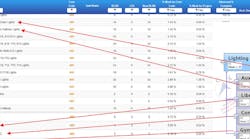Most lighting design articles seem to focus on lamp efficiency, lamp life, CRI, luminaire aesthetics, cost, and all the claimed benefits of one lamp compared to another. The one topic that always seems to be missing, however, is the properly applied steps of a true lighting design. Most electrical contractors I work with don’t use engineering data in their lighting projects. Instead, they rely on layouts from past jobs or just replicate what others are doing. By knowing the basic steps of the lighting design process, you’ll be able to more accurately price a project and present it to your customer.
At the start of the design process, always consider the following:
- Required footcandle (fc) requirement of an area, including what the customer may wants as far as lighting levels and quality of lighting.
- Code restrictions for energy savings, expressed as maximum watts per square feet, in specified areas. The two basic requirements come from the IECC (or COMcheck), which is supported by the U.S. Department of Energy (DOE) and is required by most states and jurisdictions, and California Title 24, which is more restrictive than COMcheck but also allows more flexibility.
- Photometric data, which can be obtained from most lighting manufacturers.
A good way to show you how to use this information is to address each of these items through several example situations. So let’s jump right in.
Office Space Example
Let’s say we have a 10-ft × 12-ft office with an 8-ft-high T-bar ceiling. The Illuminating Engineering Society (IES) recommendation for fc lighting level in an office space is 50 fc to 100 fc, depending on the age of occupants and the specific task requirements. We’ll use 50 fc as a target. The maximum watts-per-square-foot requirement for office space is 1.0. Using the COMcheck requirements, this allows for 120W of lighting.
Next, let’s consider the following luminaires we might use in this space:
- Luminaire #1 – 2 × 4 grid, acrylic lens, three T8 lamps at 96W
- Luminaire #2 – 2 × 4 grid, acrylic lens, two T8 lamps at 64W
- Luminaire #3 – 2 × 2 grid, acrylic lens, two T8 lamps (F17) at 34W
- Luminaire #4 – 2 × 2 grid, indirect, low brightness, two T5 high output lamps at 54W
- Luminaire #5 – Recessed specular reflector, two 26W double twin-tube (DTT) lamps at 52W
Luminaire #1 Calculations
Use the following equation to determine the appropriate number of luminaires needed for this space:
Number of luminaires = (Required fc × sq ft of space) ÷ [(lumen output of lamps) × (coefficient of utilization) × (light loss factor)] = [(50 fc) × (120 sq ft)] ÷ [(8,550 lumens) × (0.54) × (0.8)] = 1.6 fixtures
Thus, we would install two luminaires to meet the lighting requirements of this space.
Note: The values used in the above equation were acquired from the photometric report shown in the Figure (click here to see Figure) and the coefficient of utilization Table (click here to see Table). Three 32W linear fluorescent T8 lamps provide an output of 8,550 lumens. The coefficient of utilization (CU) is defined as the ratio of the lumens received on the work plane (i.e., the top of the desk) to the lumens emitted by the lamps. This is an important number and is simple to obtain. From the Figure, you can see that I chose an 80% ceiling reflectance (from the white T-bar grid), a 70% wall reflectance (from a light-colored paint), and a room cavity ratio (RCR) of 6.7 (rounded off to 7). RCR is simply the lighting efficiency of an enclosed space, and it can be easily found in lighting manuals or spec sheets. Light loss factor (LLF) is a number obtained by multiplication of all losses of light involved (i.e., dirt accumulation, lamp light losses, ballast losses, etc.). In this example, I simplified this calculation and plugged in a value of 0.8.
Installing two #1 luminaires in this space would provide a total wattage level of 192. However, because this is much larger than the 120W requirement noted earlier, it may not be a wise choice.
Do we have another alternative? Yes. We can use another value in the Figure to determine the number of luminaires required for this space.
The max candlepower distribution (CD) or candlepower is shown as 2,623 CD. This value is directly below the fixture. By dividing this CD value by the square of the distance in feet from the bottom of the luminaire to the top of the desktop, you will determine a new fc level. (Note: assume a distance of
5.5 ft from bottom of luminaire to top of desk.)
fc = 2,623 ÷ (5.5)2 = 87 fc
If we again assume a LLF of 0.8, then we end up with a final fc level of 70 (87 × 0.8).
This series of calculations shows a single luminaire provides an fc level well above the minimum recommended value of 50, which means this may be a good choice for this space. Based on this calculation method, we see that one luminaire would provide an fc level of 70 over the work desk and not exceed the maximum energy requirement of 120W.
Luminaire #2 Calculations
Following the same steps we used for Luminaire #1, we see that Luminaire #2 offers 5,700 lumens and 0.55 CU. Our initial calculations reveal that three luminaires would be needed to exceed the 50-fc requirement. Using the CD method results in an fc level of 52. This gives you the option of using two luminaires. (Note: the values for Luminaire #2 were pulled from a different photometric report, which is not included in this article due to space constraints.)
Luminaire #3 Calculations
Our calculations reveal that either method would require the use of six luminaires to exceed the 50-fc requirement. (Note: the values for Luminaire #3 were pulled from a different photometric report, which is not included in this article due to space constraints.)
Luminaire #4 Calculations
Our calculations reveal that either method would require the use of four luminaires to exceed the 50-fc requirement. (Note: the values for Luminaire #4 were pulled from a different photometric report, which is not included in this article due to space constraints.)
Luminaire #5 Calculations
Our calculations show that either method would require the use of five luminaires to exceed the 50-fc requirement. (Note: the values for Luminaire #5 were pulled from a different photometric report, which is not included in this article due to space constraints.)
A quick look back at our five different luminaire options and respective calculations reveals the best option is a balance between fc levels (and/or what the customer wants) and the maximum lighting energy that can be used in that space. In this case, luminaire #1 comes out on top.
Manufacturing Space Example
Let’s say we are asked to design a lighting system for a manufacturing space that is 200 ft by 200 ft in size with a finished floor to bottom of luminaire height of 30 ft. The owner wants a light level of 50 fc maintained at ground level. In this case, “maintained” means including an LLF. We’ll use a value of 0.7 for a dirty environment.
The maximum watts-per-square-foot requirement for manufacturing space is 1.0. For this example, we’ll use Title 24 requirements, which allows 40,000W of lighting. Two different luminaire options will be analyzed.
- Luminaire #1 – a high-bay fixture with a 350W high-output metal-halide lamp in a concentrated aluminum optical enclosure, rated at 400W.
- Luminaire #2 – a high-bay fluorescent fixture with six T5 high-output lamps and a task beam white reflector (concentrated downlight), rated at 363W.
Luminaire #1 Calculations
Following the same steps we performed in the previous example, we can pull these values from a photometric report: This luminaire offers 38,000 lumens and 0.73 CU. Subsequent calculations determine 102 luminaires would be needed to exceed the requirement of 50 fc at ground level.
102 × 400W = 40,800W (this value exceeds the Title 24 requirement). For simplicity sake, we could use 100 luminaires, which would get us close enough to the required 50-fc level.
An additional check of the photometric data reveals a spacing criterion of 0.92 for this luminaire type. What does this value represent? It means that as long as the luminaires are spaced not more than 27 ft apart (0.92 × 30 ft = 27 ft), there will be even lighting throughout this space with no dark spots.
Dividing the 40,000-sq-ft total floor space at the facility by 100 luminaires results in each luminaire serving a 400-sq-ft floor area. Therefore, each luminaire would end up being installed on 20 ft centers. Because this luminaire would not exceed the 27-ft spacing requirement calculated above, it could be a good choice to light this space.
Luminaire #2 Calculations
This luminaire offers 30,000 lumens and 0.79 CU. To exceed the 50-fc requirement at ground level, 120 luminaires would be needed.
120 × 363W = 43,560W (this value exceeds the minimum Title 24 requirement)
After running through the same steps we just performed for luminaire #1, we end up with about 18 ft center-to-center spacing for luminaire #2. Except for the slight overage of minimum watts-per-sq-ft required, this luminaire could also be a good choice for this space.
Summary
As we’ve shown in this article, the use of engineering data doesn’t have to be overly complicated. There are quick and clean methods you can use to design a simple system. One simple equation you can use to determine fc levels is: fc = [(total lumens) × (number of lamps) × (0.5)] ÷ [(floor area)]. Lamp lumen ratings of common lamps are:
- 3,000 for 4 ft T8s
- 40,000 for 400W metal-halides
- 5,000 for 4 ft T5 HOs
- 1,700 for 26W DTTs
However, there are many other factors involved in a lighting design project, including glare, on/off control, color temperature, environmental factors, aesthetics, and miscellaneous demands of an owner. Nevertheless, the calculations in this article offer a strong starting foundation. So put the engineering data you have available to good use.
Douglas is the owner of JM Douglas Electrical Engineering in La Verkin, Utah. He can be reached at: [email protected].


